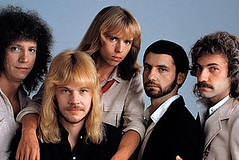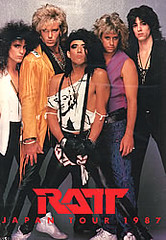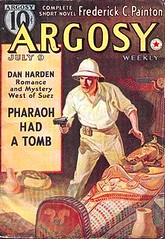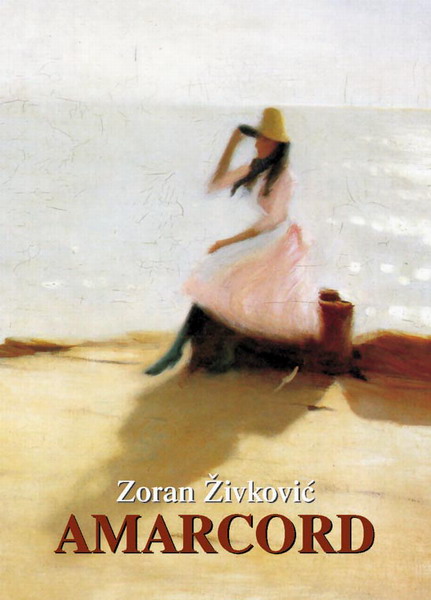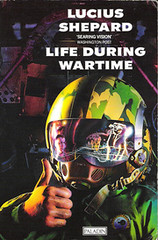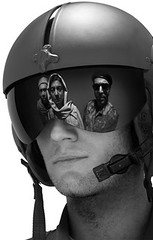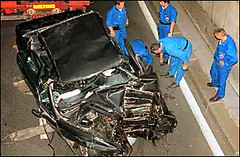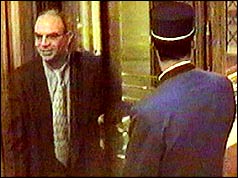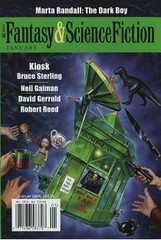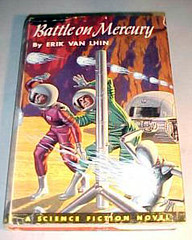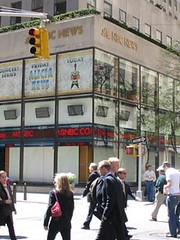In the spirit of Lou Anders’ disquisition on
Fonzie the Shaman (see the March 12 entry) let us consider the film version of P.L. Travers’
Mary Poppins. I don’t mean the novel—that’s something quite different, and unsettling in its own way, as Neil Gaiman noted in
his blog (see the Tuesday Dec. 5 entry). I mean the film.
Traditionally, horror fiction has operated on one of three dynamics, and some theories of horror have it that these are the only three axes along which horror fiction can run.
There’s what might be called Invasion, the intrusion of the horrible and terrifying into our world, the sudden appearance of the serial killer or werewolf or vampire in an otherwise normal village or town or city. I’m sure you can think of examples; from
Dracula to
Salem’s Lot to any number of slasher flicks, the horror genre is full of Invasions. Traditionally, Invasion horror fiction ends with the defeat of the monster and the reinstatement of the status quo.
There’s Revelation, in which the characters in the horror story (meaning any text, from film to poetry, rather than just prose) discover that the world is not what they knew, but is
innately horrible, and the characters who thought otherwise had been deluded. Cosmic horror works on this principle, but so does religious horror, which is why Revelation is not a 20th century invention. We think of Lovecraft first with this sort of horror, but the Victorians were conscious of the Revelation dynamic, and as far back as the sadly misunderstood
Varney the Vampire (a grossly underrated work) there are nods toward Revelation as a source of horror. Indeed, there’s even a school of thought that has the Bible as the first Revelation horror fiction.
(To those who say that Invasion and Revelation are merely ends of a dynamic continuum, and that the knowledge of Invasion has to lead a character to the Revelation of the world’s horror, I say a) hush and b) you’re underestimating the power of human denial—characters in horror fiction
always go on to assume that the world is basically peaceful and playful-kitten-nice, even if the characters have encountered the undead. In Invasion, the effects of the horror fade or are so mitigated as to be meaningless. In Revelation, the effects of the horror are permanent).
And then there’s what might be called the Trip To Faerie, in which the character(s) leave the world they know, either voluntarily or kidnapped by the Good Folk, and travel to another world, one which is full of monsters and terror. Lots of folktales have this, and even Walks Into The Wood do, and things like
Peter Pan and
Pinocchio and the stories of Oz and so forth. (Not to mention
Hostel and every other tourists/travelers-in-danger film). The important thing is that the other world isn’t ours or in ours, and isn’t easy to get to, and isn’t a good place to be.
Writers don’t generally write programmatically, I think. They might decide to write a book using the plot of "Prometheus Bound" or to endorse or rebuke the tenets of the Mundane SF or New Weird, or even to replicate the premise of
Gilligan’s Island, but, from what I can tell, most writers don’t decide to warp their plots to fit schools of fictional theory. Theory follows plot, and not vice-versa. So most horror fiction generally follows (however unconsciously on the part of its writer(s)) only one of these three theories.
But every now and again you get a work like the film version of
Mary Poppins, which deftly manages to use of all three of these dynamics, as if the writers meant to demonstrate each. More: to provide a survey of horror tropes and methods, and to anticipate a few.
"Ho ho ho," you say. "Silly Jess--
Mary Poppins is a magical work, something kids love! It has no horror content whatsoever."
Ha, I croak. Have you seen the movie recently? I don’ t mean in that
funny video mashup that’s floating around. I mean, as an adult, watching it with an adult’s eyes and not through the gauzy, saccharine filter of childhood memories?
It’s horror. Deeply sinister horror.
I saw
Mary Poppins recently, thinking that the
Mary Poppins singalong would be as charming as the
Sound of Music singalong. Instead, it was revelatory, and not in the way that the
Sound of Music was. (Honestly, until I saw
Sound of Music as an adult I didn’t realize that Uncle Max was supposed to be gay. But that’s how he’s coded, without a doubt).
The preferred inscribed narrative of the film—that is, the story that the filmmakers intended to tell—is essentially a conservative one. The suffragette activist mother (and implicitly her cause) is made to look both foolish and a bad mother. The working classes are shown cheerfully going about their demeaning, life-shortening jobs and are quite content with their oppressed lot in life.
However, as the formidable Ken Hite has noted, there isn’t necessarily anything contradictory about conservatism and horror. And consider the following:
--the film has a sequence of the nanny applicants being blown into the air so that Mary Poppins can take the job. Could be funny. But the scene becomes surreal, filled with images that would not be out of place in Bunuel. No sliced eyeball, naturally, but as filmed the wind-tossed nannies are disturbing, and not in a good way.
--Mary Poppins’ mirror image moves and acts on its own. It smiles now—but what is it doing when the children are asleep? Is it still there, looking at them? Does it—can it—affect the children’s reality?
Heroes nods at this, with Mirror Jessica haunting Niki, but the show doesn’t make full use of this. Neither does
Mary Poppins, but in context Mirror Mary Poppins is actually more disturbing than Mirror Jessica.
--Mary Poppins, Bert (Dick van Dyke’s character), and the children travel into the world of Bert’s street drawing--a classic Trip To Faerie. And while the world of the drawing seems to be some sort of Edwardian idyll, there are many hints that it’s actually Pinocchio’s Funland, and that Mary Poppins is Virgil to Bert and the kids’ Dante, the guide who is the only protection from harm that the children have. The world is intended to be cute, and indeed most of us found it so as children, but as adults…? Ye gods. Never mind the animated, flying and apparently sentient calliope horses (not an image conducive to kind dreams)—there’s a fox hunt going on in which, and this must be stressed,
the fox has a personality and can speak. Fox hunting is loathsome enough in reality, but the deliberate and conscious hunting of a sentient being? What kind of monsters live in this world? And while the children appear to be unharmed by their trip into the drawing world, and feel that it’s just Big Rock Candy Mountain, anyone who’s read Machen’s sublime
"The White People" knows what happens to children who are subjected to too many Trips To Faerie. (And did the children eat while in the drawing world? If they did…well, anyone who’s read
Lud-in-the-Mist knows what a mistake that would be).
--During the trip into the drawing world Mary Poppins looks at the camera and speaks. This takes place during a conversation with Bert, but it’s quite clear that she’s breaking the Fourth Wall and speaking to the audience. I realize metafictional horror is by now past its sell-by date as a genre, and no one will ever do it as well as Grant Morrison did it in his run on
Animal Man (the high point in metafictional horror fiction), but as with so much else, context is everything, and the momentary appearance of metafictional horror in what is ostensibly children’s fiction is almost shocking. (And, no, I’m not too proud to admit that I may have shrieked "DON’T LOOK AT ME!" when Mary Poppins broke the Fourth Wall). It’s especially unnerving when the breaking of the Fourth Wall doesn’t create terror in the fictional characters, but rather results in an implicit threat to the viewer—and that’s what Mary Poppins’ eyes hold, when they look at us and speak in this scene.
--Cannily, the film does not restrict itself to just the tropes of supernatural horror. Consider Bert. A good man. Hard-working—he’s a street artist, a chimney-sweep, and who knows how many other jobs. (We can talk all we want about the good old days of Victorian and Edwardian London, but the truth is that they were brutal places for the working poor, and while
Mary Poppins might intend to sanitize the kind of life poor Bert is forced to lead, the filmmakers were honest enough to at least nudge the viewer toward a contemplation of what Bert’s life must be like. I doubt he works so many jobs because he wants to, and he may even be sleeping rough). Bert acts kindly toward the children, and uncomplainingly puts up with the not-so-veiled class condescension of the father, Mr. Banks. And Bert draws his world in colored chalk, and accompanies Mary Poppins and the children into it, and walks and dances with Mary Poppins. His behavior is obviously that of a man in love with Mary Poppins—you have only to observe the way he acts toward her to recognize that. What is her reaction to his courting of her, for that’s what he’s doing in the trip to the drawing world? She dismisses his feelings with a patronizing and amused "just good friends" demurral. (Not in those words, but in context its very clear what she means). Worse, her words are a kind of emasculation of him; she not only turns him down, she reduces his feelings to being only sexual, and then slams the door on him. (It’s hard to interpret her "wouldn’t take advantage of a lady" comment in any other light).
(I’m tempted to make a comment here about Dick Van Dyke’s "Cockney" accent as another, different kind of horror, but I’ll let it pass).
--The trip to the drawing world comes to an end when the rain hits the drawing, causing it to melt and the world inside it to melt into a psychedelic smear of colors. Mary Poppins et al. survive the transition just fine, but what of the beings inside the world? Do they survive the rain, or are they, too, destroyed by it? Bert’s not surprised by the effect the rain has on his drawing and on his world—if anything, he rather blithely accepts it. Doesn’t the demi-urge have a moral, if not familial, responsibility to his or her or its creations? Isn’t the overriding lesson of
Frankenstein not that there are "things man is not meant to know," but that those who create shun their responsibilities to their creations at their own peril?
WTF is Bert doing? He brought the world into being, and then accepts its destruction with a shrug? At the least he could have painted this world, then set the painting aside so that it might survive. But he does not, and instead lets it be destroyed—an act Mary Poppins acquiesces in. "Callous" doesn’t begin to describe that. "Sociopathic," perhaps? Or simply the old-fashioned "monstrous"?
--A further way to regard the transition is to look at its visual depiction. A swirl of bright (too-bright) colors, the drawing world washing away and being replaced by mundane reality. It’s a given of metafictional horror that sooner or later the characters realize that they are just that, characters (see: the stories in
Metahorror, Morrison’s
Animal Man,
The Thirteenth Floor, etc etc etc), and genre critics sometimes make the mistake of thinking that metafiction in which characters don’t realize they are fictional constructs is thereby flawed. (Yes,
Gary Westfahl, I’m looking at
you). Nonetheless, in a work of horror, like
Mary Poppins, it’s almost required that the characters have their negative ontological revelation. It’s an efficient way to jolt the reader and provide a new and different kind of horripilation. (Or, rather, it was an efficient way to provide a new and different kind of horripilation about, oh, 15 years ago. Now, it’s so tired it’s asleep).
Naturally, this doesn’t happen in
Mary Poppins. Except for one or two hints later on (see below) none of the characters betray the slightest hint of self-awareness. So is
Mary Poppins not horror, then? Did its creators deliberately shirk their responsibility to complete the terror, and instead leave us with
metus interruptus?
Not at all. The key is to look at the visual depiction of the transition, the swirl of colors. They are brighter than bright, more real than real.
One definition of cosmic horror is that reality--true reality--is so terrifying that the human brain can’t deal with it, and that what humans perceive as reality is a delusion and/or our mental defense mechanisms at work.
What defense mechanism is at work in
Mary Poppins? For one, the swirl of colors. We’re not actually seeing that. Our minds are only telling us that we’re seeing colors. What is actually visible in the background is too horrible for us to glimpse, a reflection of our faces in the waters of Lake Hali. The filmmakers of
Mary Poppins anticipated Theodore Roszak’s work in
Flicker and put Wrongness on film, perhaps in the interstices between frames. Our pitiful monkey brains just can’t handle it, and so we see pretty, pretty colors.
No wonder the children act as if nothing’s wrong, after they return. They’re in denial.
Alternatively, and this may be a better explanation, the swirl of colors is a post-production addition, by censors or by a thinking-the-better-of-it director or producer, to replace what had been a terrifying sequence. As we’ll see, we have some reason to believe that they are capable of this.
--And what is Mary Poppins’ reaction, when asked by the children about the trip, after they return? She denies that the trip took place. Now, I’m all in favor of an unreliable narrator--
Detour is one of the greatest
films noir ever made, and only heathens think otherwise—but this is not a situation where that is appropriate. So why would she say that? To mess with the kids’ minds, and cement their denial about the trip, so that the wretched truth might worm through their ids and produce something wicked? Or is it to mess with
our minds, and make us doubt what we’ve seen? Mary Poppins, to this point in the film, does not appear to be a liar. It’s out of character for her. So why lie now?
Not for a good reason, that’s for sure. No, she has some dire ulterior motive.
--Consider "supercalifragilisticexpialidocious." Memorable word. Refrain of a catchy tune. Everyone in the film hears it once and remembers it ever after.
So what do we call the song or phrase which lodges itself in our consciousness and won’t leave?
A meme—that’s what we call it. An idea which acts like a living organism, replicating itself.
So what does our little meme do? Infects everyone in the movie, even the possibly senile bank chairman, and then imprints itself on the soundtrack, and then exits fiction and spreads itself through our culture, until it finally has such a grip that even a kludge like MSWord’s spellcheck lets it pass. "Supercalifragilisticexpialidocious" is now immortal. Thanks to that damned song, it’s imprinted itself in the part of our brain that appreciates music, a much more primal part than the part of our brain that understands words. It can be heard around the world, and non-English translations of the movie and song retain the word. It’s as recognizable as any visual icon, and if I were to stand up right this moment, in the train station at King’s Cross where I’m writing this, and begin singing the song, I guarantee you that well over 75% of those who heard me would recognize and perhaps even sing along. We were warned in the movie itself—the very
song tells us that it’s "really quite infectious"—and yet we didn’t listen, and know we’ve got an idea parasite which will survive half the world being nuked, because the other half of the world will still be carriers and vectors for it.
What, you don’t find that horrible?
--Strangely, some people find the scene with Uncle Albert to be charming. You remember him—he’s the one who seems to laugh compulsively, and when he does he floats up the ceiling of his flat. And when others are in his presence, such as Bert and the kids, they float up the ceiling when he laughs. Oddly, this is taken to be a light-hearted moment of comedy. What’s clearly going on here is a form of infectious possession--because we all know, don’t we, what sort of person floats to a ceiling, later to crawl in it: those ridden by demons.
--The way in which
Mary Poppins veers between the supernatural and the memetic in its survey of horror is quite effective. Rather than moments of ordinary, family-based terror being out of place in the film, those moments drive home the horror that the children must endure. There truly is no hope for them, or for the father. (The mother in
Mary Poppins is so devoted to the suffragette cause that she is essentially absent from the children’s lives, and not treated by the father as an important part of his life or of the children’s. The mother doesn’t count in
Mary Poppins except as a figure of mockery).
These ordinary horrors?
The children are stuck in a household run by an absentee mother and a father so wrapped up in his self-defined (or perhaps societally-defined) roles that he has no love or kindness in his heart for his children, something they understand, whether consciously or subconsciously, and react to by tormenting successive nannies. For a brief time the children get a great new mother figure in the form of their new nanny, only to find themselves betrayed by Mary Poppins, who lies to their parents about the trip to the drawing world—-and the parents believe Mary Poppins, rather than the children. The lesson they learn here is that their parents don’t trust them and don’t believe them, and that Mary Poppins herself is not to be relied upon. In this moment the children lose not just their wonderful new nanny, but their parents as adults who can be depended upon and who will shield them from the evils of life. This is not something that only happens in fiction, and is devastating when it takes place in real life.
For his part, the father is displaced from his role as head of the family by Mary Poppins, and Mary does this to him in front of the children, so that the children are aware of who the new Alpha Male is in the household, and the father is aware that the children know this. The film has stressed how vital to the father’s self-image is his role as banker and father, and how important to him order and control is. Mary Poppins, in short order, displaces him as head of the household, and takes away control of the family from him. And all he can do is watch it happen.
Emasculation in this fashion is, when done to the right person, great fun to watch—who among us would not enjoy watching Donald Trump being reduced to a homeless eunuch?—but the father is not the right person. He is not a deserving victim in this case.
It may be instructive to consider the father as an analogue to Annabella Sciorra’s character, a mother, in
The Hand that Rocks the Cradle. It passed unnoticed by men at the time, but
The Hand that Rocks the Cradle was a big hit among women, who properly saw it as an unusual domestic horror film. The high point of the movie, and the scene which provoked a unique frisson of both terror and outrage among many women viewers, was when Sciorra saw Rebecca de Mornay’s nanny breastfeeding Sciorra’s children. For men, this moment passed unremarked-upon, for the most part, but many women reacted strongly to this scene, as the filmmakers undoubtedly planned. To have another woman breastfeed your child, as many female viewers of
The Hand that Rocks the Cradle said, would be to suffer a unique form of violation.
This is not something that most men are going to react to with their emotions, simply because it’s sufficiently alien to our experience as men that while we can appreciate it intellectually we likely will not react to it emotionally. But to be emasculated in the eyes of our children, in the way that Mary Poppins does, and to have the children see that an outsider is the real head of the family…that is something many men will react emotionally to.
(I should note that
Farah Mendlesohn has pointed out that, in Edwardian households, the nanny was the head of the household, as far as the children were concerned, and had a unique position among household servants, and that it was understood that father would not watch over their children the way the father in
Mary Poppins did.)
--Nor does the film scant on economic horrors, the sorts of terror which are quite possible in what passes for real life. The run on the bank, caused by nothing, and the loss of the job due to the foolishness or maliciousness of a boss—-these are easily realized outcomes for many, and consequently even more terrifying than the memetic threat of "supercalifragilisticexpialidocious."
--The filmmakers have enough intellectual honesty to bring the children away from the false idyll of their home life and expose them to the grimy reality of London, which in turn leads to the urban horror of the film. The children, and the viewer, see the pigeon lady (the hopelessness and despair of lonely old age in the city) and the chimney sweeps (men forced to work the filthiest jobs in the city)—-and, of course, the children are forced to run through a frightening section of the city, out to the docks.
--The filmmakers also manipulate the film’s conservative ideology to create further frights. The essentials of the Banks’ life are, it must be admitted, attractive: a financially and socially secure middle-class existence in a cozy borough of London. The film then threatens to take it all away. Job- and class horror—economic horror--the threat of financial calamity and the resulting social and economic disruption and disaster, must not be understated as a source of fright. It’s not something that most of us would have felt or even thought much about as teenagers or in our twenties, when most horror readers do the majority of their horror reading. But on the wrong side of forty the prospect of abruptly losing your job, and thereby your house, and starting over, is frightening.
The film makes this worse by the method in which the father loses his job. Most people have had a job in which their superior was unreasonable on one subject or another. But to be forced to work in a job in which we must toady to a group of unreasonable and hidebound men, led by a possibly senile figure? That’s frightening. And then to lose the job because of the superiors’ complete unreasonableness? (And to be symbolically castrated in the process-—witness what they do to his precious hat). Scary—and far too realistic.
-
Mary Poppins is securely within the continuum of economic horror films, although naturally it’s not thought of as such. Consider the scene in which Mr. Banks confronts the bank board, fully aware that he’s going to be humiliated and have his job taken away. Compare the way that scene is initially filmed to the sequence in
Network when Peter Finch’s Howard Beale is called to heel by Ned Beatty’s Arthur Jensen.
Similarly, compare the way Dick van Dyke’s Mr. Dawes, Sr., is filmed with the way that Lionel Barrymore’s Mr. Potter is filmed, in
It’s a Wonderful Life, another film of economic horror. Coincidence? Obviously not.
--The last third of the film is where
Mary Poppins ventures into really scary waters. The bank chairman is possessed first by the "supercalifragilisticexpialidocious" meme and then by the demon of laughter—-a scene, note, that ends with a flash of demonic red light. (Don’t believe me? See the movie and pay close attention to that scene and how it ends. Demonic freaking red light, I tell you).
The father, post-job loss, returns home with a completely different personality. It’s either been rewritten due to the "supercalifragilisticexpialidocious" meme—-or what steps through the door is not the father, but a doppelgänger. The children recognize this: their reaction to his arrival is that he is "something that only sounds like him." (Yes, one of them says that). They allow denial to convince them otherwise, but for a brief moment they see the truth. (The greater attractiveness of the doppelgänger of Mr. Banks to the real thing is a clear hint that the filmmakers were choosing
Poe’s "William Wilson", with its morally superior doppelgänger, rather than stories like Bulwer-Lytton’s
"Monos and Daimonos", in which the doppelgänger is evil.)
Returning to the scene in which Mr. Banks loses his job, there’s still another metafictional moment. Mr. Banks tells the bank chairman, Mr. Dawes Sr., that "There’s no such thing as you!" Indeed there isn’t--nor is there such a thing as Mr. Banks. He’s a fictional character. It’s just that in this scene, for a brief moment, he becomes aware that he’s surrounded by unreal characters-—and in all likelihood his own status as a fictional construct. Given that we’re meant to identify with him, we might consider the horror of that dawning knowledge.
Finally, consider the film’s true ending. Mr. Banks has been either driven insane or replaced by a doppelgänger. Mrs. Banks is now the wife of a man who is out of work and has bad references, and Mrs. Banks is clearly unfit to hold the sorts of jobs available to women in London at this time. The children have been through multiple trips to Faerie, and come through the worse for it, their minds likely in torment because of the conflict between what they know and what they wish they didn’t know. The bank has been ruined, and the Banks’ saving may well be gone. Personalities, social positions, and lives have been ruined, and all because of the arrival of Mary Poppins.
What does this remind us of? The influence of Robert W. Chambers’
King in Yellow. The narrator of the novel describes the play this way:
"I pray God will curse the writer, as the writer has cursed the world with this beautiful, stupendous creation, terrible in its simplicity, irresistible in its truth a world which now trembles before the King in Yellow. When the French Government seized the translated copies which had just arrived in Paris, London, of course, became eager to read it. It is well-known how the book spread like an infectious disease, from city to city, from continent to continent, barred out here, confiscated there, denounced by press and pulpit, censured even by the most advanced of literary anarchists. No definite principles had been violated in those wicked pages, no doctrine promulgated, no convictions outraged. It could not be judged by any known standard, yet, although it was acknowledged that the supreme note of art had been struck in The King in Yellow, all felt that human nature could not bear the strain, nor thrive on words in which the essence of purest poison lurked. The very banality and innocence of the first act only allowed the blow to fall afterward with more awful effect."
Is that not a fair assessment of Mary Poppins, both figure and movie? And isn't Mary Poppins' background unknown and mysterious, just like the King's?
Naturally, the filmmakers or producers could not allow a movie meant for children to end on quite so dire a note, so a wholly-unconvincing happy ending was tacked on to
Mary Poppins. The film is in good company in suffering this fate; the forces of the Tsarist government did that to Dostoevsky’s
Crime and Punishment. But readers and critics see through the ending of
Crime and Punishment and ignore it, considering only what Dostoevsky really wanted to include in the novel. So, too, will readers and critics eventually treat the ending of
Mary Poppins.
--Finally, no consideration of horror in
Mary Poppins would be complete without a contemplation of Mary Poppins herself. Set aside for the moment what she does to the children: exposing them to magic and possessed toys, taking them to Faerie, and so on. Ignore her obvious lie that she is "practically perfect in every way." Simply look at her: the jacket which obscure her curves; the high collar; the long skirts; the hard, high boots; the phallic umbrella. All of her female signifiers are suppressed, and she rarely smiles, so that the children receive no affection from her at all. At the end of the movie, she leaves the children (who despite all reason have become attached to her) without saying goodbye, adding more scars to the children’s psyche, and undoubtedly leaving them
Who is Mary Poppins?
Harry Harlow’s wire mother, that’s who.
So beware of terror and fright, my friends, on behalf of you and your children. Keep watching the screens—KEEP WATCHING THE SCREENS!
(I should add that I’ve rarely angered my wife, who loves
Mary Poppins, more than when I ran the preceding by her. She actually punched me—hard—on the arm, which is quite out of character for her).



